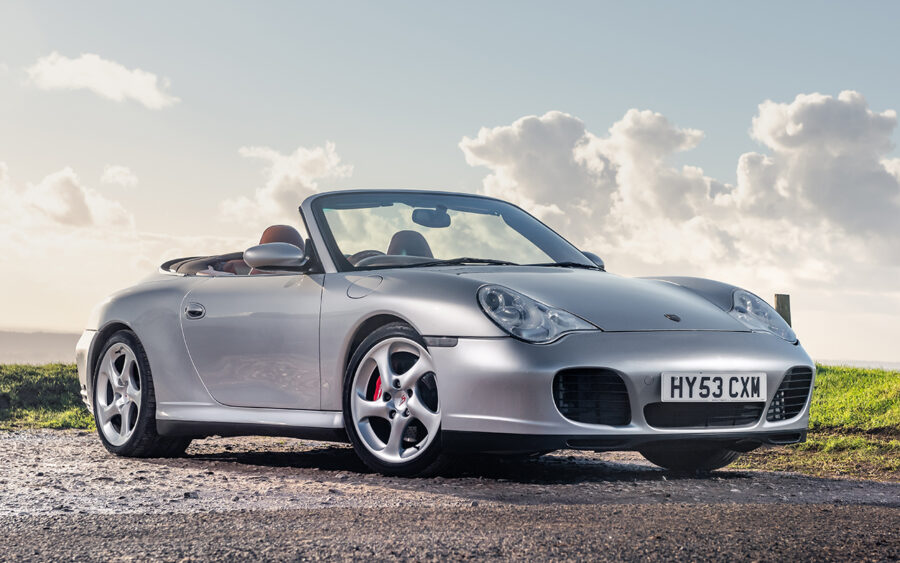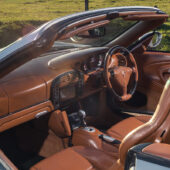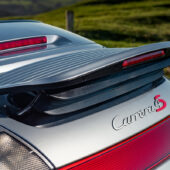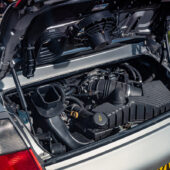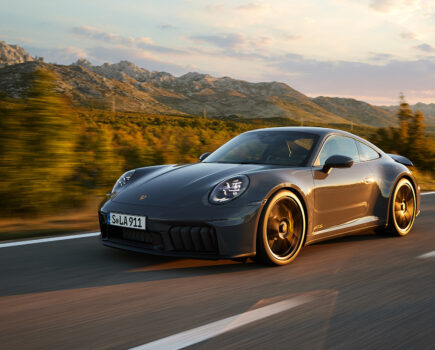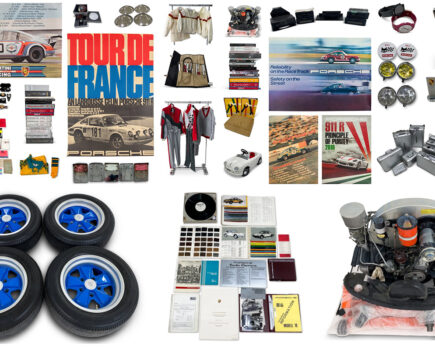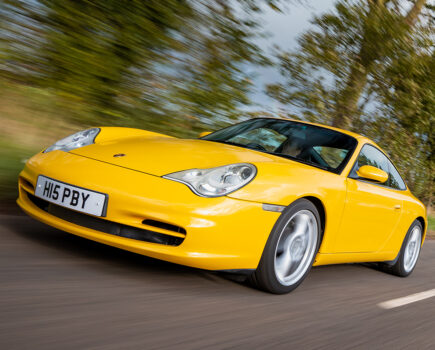The four-wheel-drive, wide-bodied Porsche 996 C4S offers a tempting combination of all-round ability and performance. Here’s how to buy one
Words: Dan Furr, Emma Woodcock Images: Dan Sherwood
There’s nothing unusual about an all-wheel drive Porsche; faced with the modern model range, Porsche customers are spoilt for traction-first choice and even today, earlier four-wheel drive Porsche 911 models are appreciated for the extras they offer over their equivalent rear-wheel drive machines.
Back in 1989 the introduction of the 964 first brought the Carrera 4 moniker to market. Making use of a planetary centre differential, this air-cooled 911 was a simple yet effective first step, which — all-wheel drive aside — differs little from its rear-drive Carrera 2 sibling. The subsequent 993 Carrera 4, introduced in 1994, follows the same approach and the recent 992 Carrera 4 and Carrera 4S are equally modest, both using the same body shell as the basic Carrera.
In between these generational extremes, however, Porsche took a chance on something different. Sitting just above its stablemates, the Porsche 996 Carrera 4S – known by enthusiasts as the C4S was introduced in 2002 and is the most aggressive early water-cooled 911 this side of a Turbo or GT3. Eschewing the standard body of a two-wheel-drive 996, the ‘C4S’ flexes extra muscle in its rear quarters and carries Turbo exterior styling, save for the force-fed model’s side intake vents.
With more power and displacement than the 996 Carrera 4, plus a sprint to 60mph in less than five seconds, the C4S is simply the best all-rounder of the 996 range, combining trademark four-wheel drive surety with the Turbo aesthetic. Best of all, this boisterous machine can currently be yours for less than £20k, though it’s best to buy forewarned — both the 996 C4S and its first-generation 997 successor have the same unfortunate association with engine issues as any early water-cooled Porsche. Buy wisely, however, and you’ll be rewarded with the best-value 911 currently available.
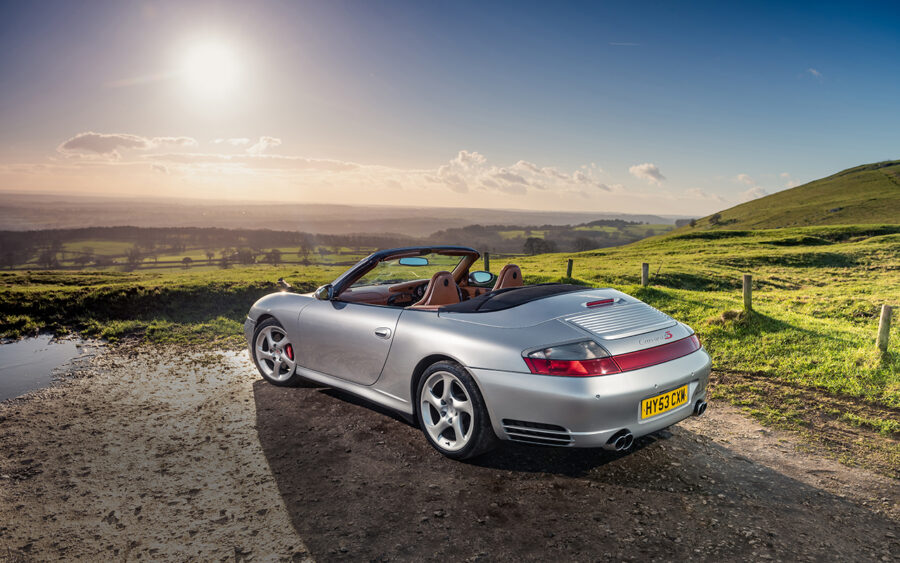
Bodywork
Visually only the electronic Carrera spoiler, full-width rear light bar (missing from the later early 997 C4S) and the loss of both rear wheel arch vents differentiate this imposing, naturally aspirated machine from a full-blooded 911 Turbo. Even now, the 996 C4S looks like it means business.
Styling isn’t the only similarity between the 996 Turbo and C4S. The naturally aspirated car also borrows the 18-inch wheel styling of its Turbocharged cousin. The twisty five-spokes measure eight inches wide at the front and 11 inches at the rear, with Turbo-equalling 225- and 295-section tyres respectively. 330mm drilled discs and four-piston monobloc calipers occupy the corners, while the suspension uses Turbo parts to sit firmer and 10mm lower than any other 996 Carrera.
The easiest way to correctly verify the identity of the car you’re looking at is to check its VIN. Make sure it matches what’s printed on the V5. Elsewhere on the same document, you’ll see the car’s engine number. Various online services are available to check a car’s history this way, so be sure to check any potential purchase – and do the same on the DVLA’s site. The VIN can also be decoded online to determine the car’s exact specification.
The bodywork on the 996 is of the highest quality (Porsche provided a ten-year anti-rust warranty). With the exception of the area below the door catches (primarily early 996s), rust is rare and may therefore be evidence of a badly repaired smack. Check the body carefully for dents and signs of repair. Also check underneath the car for a misshaped floorpan, another sure sign the car has been involved in an accident. Ask for details of any damage and repairs, and make sure you see receipts for the work. Be satisfied with the quality of any repairs before making an offer for the car.
Engine and transmission
996 Carrera 4S power comes from a 316bhp version of the familiar 3.6-litre flat-six, with maximum output developing at 6,800rpm. While both this engine and revised headlights (so long, fried eggs!) feature on every 996 Carrera built in and after 2002, only the 911 C4S has the hardware and hips to claim a legitimate relationship to the Turbo.
Cracked cylinder heads were a problem on some early 996 models. Reading forum posts may lead you to conclude there has been an epidemic of cracked cylinder heads and liners on M96 engines. In reality, the issue is relatively rare and the prominence of horror stories published online is due to unlucky owners venting after being on the receiving end of large repair bills. Unless you have access to specialist equipment, the problem is very difficult to spot in its early stages. Given the price of a replacement engine, it’s well worth investing in a borescope inspection before buying a 996 Carrera 4S, thereby helping you to establish if expensive failure is imminent.
A claim heard often is that cracked cylinder heads and liners occur between 25,000 and 50,000 miles. In truth, the problem can strike on higher mileage cars, too. A more relevant piece of information is to keep in mind early 3.4-litre engines have proved much more prone to this problem than the post-2001 3.6-litre units.
The rear main oil seals (RMS) were a weak point on Porsches of this era and leaks are not uncommon. Although the seal itself is an inexpensive part, labour for the work can be costly, primarily because the seal is very difficult to access. If you spot an oil leak on the C4S you plan to buy, ask a Porsche specialist to take a look. A leak doesn’t always mean the RMS needs to be replaced immediately — the work can often be delayed until a bigger job (such as changing the clutch) needs to be carried out, but it’s certainly something to note as likely to need attending to in the future.
One of the most serious issues on the 996 flat-six is failure of the factory-fitted IMS bearing, which can lead to catastrophic engine problems. An IMS is used to transfer power between crankshaft and camshafts. At one end of the IMS sits a plain bearing, while the other end is fitted with a ball bearing. Three different types of ball bearing were used during M96/M97 production, starting with a dual-row ball bearing in 1996. A smaller single-row ball bearing was introduced three years later. The IMS and its plain bearing are submerged in oil during normal operating conditions and the ball bearing is filled with grease protected from the engine oil by a seal. Differences in manufacturing tolerances can result in seal failure and material mixing with the grease, thereby wearing out the bearing, resulting in failure. If the bearing lasts for several years, however, there’s a good chance it will continue operating without fault long into the future.

A misfiring engine (or one sounding rough when running) may be a sign of problems with the ignition coil packs. Over time, heat from the engine and exhaust can cause the coils to expand and the insulation to crack. The only solution is to replace the parts. Thankfully, it will be relatively inexpensive to have the work completed by an independent Porsche specialist. The packs are likely to have to be replaced several times during the car’s lifetime.
The coolant radiators in the front bumper (and the air-conditioning condensers located directly behind them) are susceptible to stone chips and corrosion resulting from dirt, salt and leaves coming in through the air scoops. In an ideal world, the debris would be regularly cleaned away, but most 996 owners never attempt it, leaving plenty of time for damage to develop between services. Suspect radiators and/or condensers will need to be replaced to avoid overheating and the loss of air-conditioning.
Both the 996’s sequential Tiptronic gearbox and later PDK allow manual override — leave the gearbox in drive and let the car take care of shifting for regular driving, then switch to manual controls and move up and down the cogs using the steering wheel-mounted. If you prefer ‘flappy paddles’ rest assured there are many online guides illustrating how to add them to a Tiptronic 996 or 997.
The primary four-wheel drive hardware underpinning C4S variants of the 996 and early 997 is identical to that used by the Carrera 4 of the same generations. The entirely mechanical arrangement acts as an addition to the rear-drive system used by all 996 and 997 Carreras — two and four-wheel drive variants — and uses a Cardan shaft to bring power forward into a ZF assembly driving the front wheels. The construction contains two major components: an open differential and a viscous coupling. It’s the latter of these which gives the four-wheel-drive versions of the 996 and 997 their ability to vary the percentage of power sent to the front axle.
An entirely automatic process, these changes are brought about by any speed difference between the front and rear driveshafts, which are connected to a dense collection of vanes within the viscous coupling, rotating inside a bath of heat-sensitive fluid. As driveshaft speed increases, the liquid begins to warm, becoming increasingly firm and sending energy forward from the faster-spinning rear vanes to the front. The Porsche system always transfers a minimum of five percent power to the front wheels, but this slowly rises with speed, reaching thirty percent at 155mph and spiking to forty percent when the rear tyres lose traction.
The coupling’s front axle location is a change from the centre-mounted all-wheel drive systems used in 964 and 993 Carrera 4 models. This alteration allows the 996 and 997 system to dovetail with both a six-speed manual and five-speed Tiptronic gearbox. Current values vary little between the two transmission types, showcasing the adaptability of the Carrera 4 and C4S platforms.
The Tiptronic gearbox has demonstrated itself to be very reliable, but the cooling pipes have a tendency to rust after a few years of being exposed to dirt and road salt. Thankfully, replacing these parts is a relatively inexpensive job.
A full service history demonstrating the C4S you’re looking at has been subject to the correct service regime (and work has been carried out by a reputable Porsche specialist) is a good sign, but be wary about cheap examples maintained at non-expert garages — ask to see the last service invoice, which should feature a list of advisories. If the recommendations have been acted on, the seller should be able to produce invoices for the work. If not, the information will give you an idea of what maintenance costs are likely to be during the first twelve months owning the Porsche you’re thinking about buying.

Suspension, steering and brakes
This incarnation of the 911 is much lighter on its stoppers than most sports cars of the same vintage, but as with all cars, the brakes need to be replaced every few years. Make a visual check of the discs for signs of rust and warping, and also see if the car shakes or pulls one way when braking — these are signs consumables will need to be replaced in the near future. If the pads and discs have been changed recently, ask to see receipts. The job should have been undertaken using quality parts.
Due to the hard driving Stef and Gareth subject their 996 to at weekends, they’ve decided to fit bigger brakes to the car for additional stopping power. This is a sensible move. Thankfully, a high number of high-performance discs, pads, hoses and caliper upgrades are available for the 996 from a variety of aftermarket manufacturers and retailers.
The 996’s suspension was superb for its day and has proved to be very durable. The only problem you are likely to encounter is creaking or rattling from the front or rear corners, which is a sign the control arms/tuning forks are either worn or have been damaged. Replacing them is a simple and relatively inexpensive job, which will probably need to be done every three or four years. Parts are cheap and readily available.
Corrosion of the exhaust fasteners, bolts and nuts is a common problem which can lead to exhaust gas leakage. A visual check will identify the fault, but you may need access to a lift in order to get a proper view. There is no alternative to having the parts replaced.
Plenty of 996 owners choose to upgrade the factory-fitted exhaust with a sportier alternative promising additional noise. It’ll sound great on a one-off test drive, but you may not find increased volume quite as pleasing every day, especially if you’re buying a Carrera 4S Cabriolet. As with any modification, you should ask for details of the parts fitted and check to make sure the work was carried out by a reputable specialist.
Porsche 996 Carrera 4S: our verdict
Manufactured between 1997 and 2004 (two further years for the mighty Turbo S, GT2 and GT3 models), the 996 was the first 911 to feature a water-cooled engine. Despite grumblings from Porsche purists, the model proved a hit with the wider motoring public — worldwide sales figures of more than 175,000 units made the 996 one of the company’s most popular products. Lofty sales figures means there are plenty of 996s available for those delving into today’s used Porsche market. Despite the 996’s healthy reliability record, however, not all of the available examples are sound buys.
Choose a 996 which has been properly maintained and you can look forward to years of enjoyable driving, but pick one neglected by its owners and you can expect sizeable repair bills. A comprehensive pre-purchase inspection will pick up any imminent problems and give you peace of mind, but it’s useful to know what you should be looking for when you head out for a test drive.
The 996 Carrera 4S’s four-wheel drive capabilities make it practical enough for everyday use in more or less all driving conditions. And, contrary to popular belief, when it comes to the 3.6-litre flat-six, there is no reason to worry about high mileage, as long as the car has been well maintained. In fact, low mileage examples may require extra checks — these cars like to be used regularly.
Keep in mind, a 996 with very low mileage may well have been used primarily for track days. Ensure you are fully aware of how the car has been cared for.

